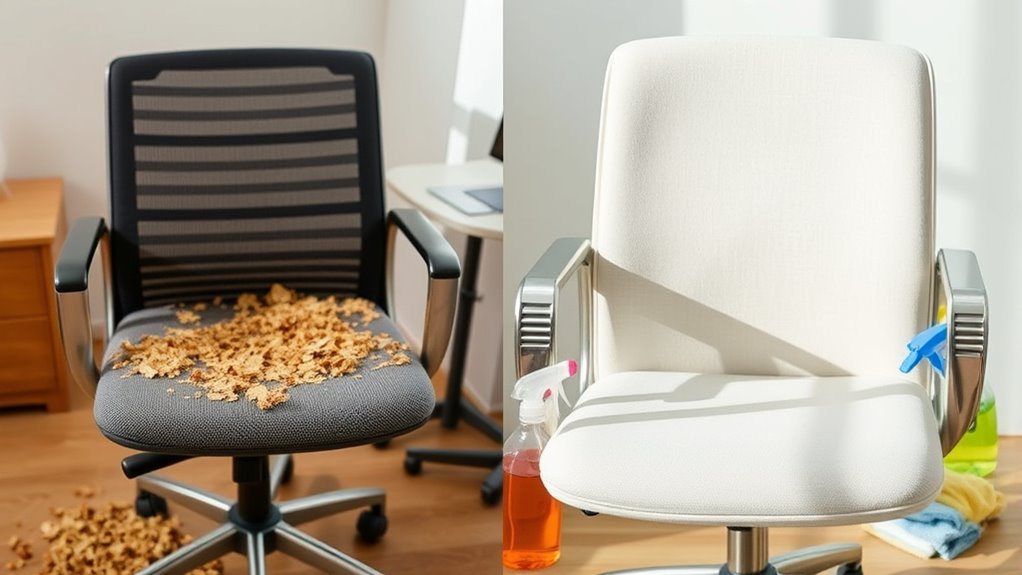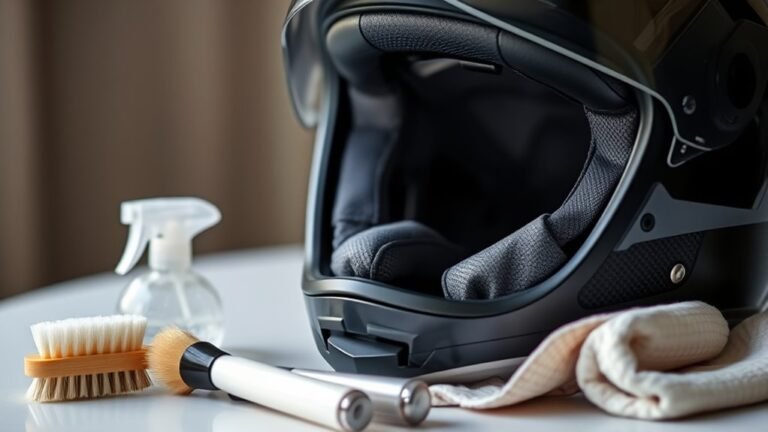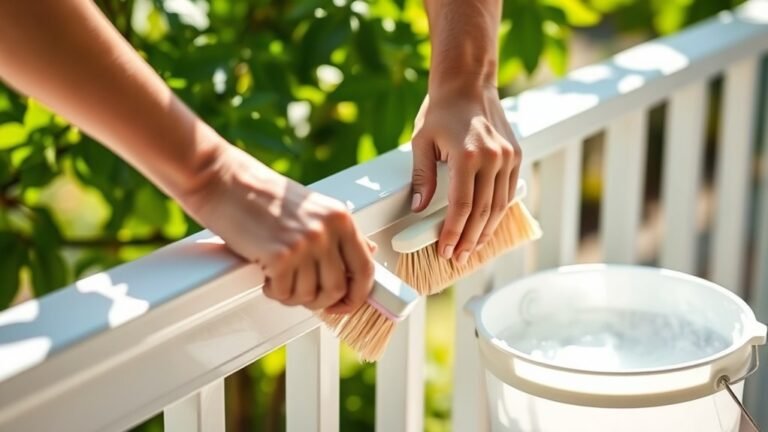Cleaning Tips Before and After Office Chair
Before and after using your office chair, start by identifying its material to pick safe, effective cleaners. Remove dust and debris with a handheld vacuum or brush, focusing on seams and wheels. Treat stains promptly with mild, material-appropriate solutions. Wipe down the frame and flush out wheels regularly, lubricating them to keep movement smooth. Establish a consistent cleaning routine based on usage to maintain appearance and durability. You’ll discover thorough steps to keep your chair in top shape.
Assessing the Material of Your Office Chair

Before you begin cleaning, it’s crucial to identify the material of your office chair, as different fabrics and surfaces require specific care methods. Start by examining the chair’s label or manufacturer’s guide to determine fabric types such as mesh, leather, vinyl, or polyester. Each material demands unique treatment—leather needs conditioning, while mesh benefits from gentle washing. Recognizing your chair’s material helps you select appropriate cleaning products, avoiding damage and ensuring longevity. Avoid harsh chemicals on delicate fabrics and opt for mild detergents or specialized cleaners instead. By understanding material care requirements, you’ll maintain your chair’s appearance and comfort without compromising its integrity. Taking this step grants you the freedom to clean confidently and effectively, tailoring your approach to the exact fabric types involved. Using gentle fabric cleaners tailored to your chair’s material ensures safe and effective cleaning without harm.
Removing Loose Dirt and Debris
Start by tackling the loose dirt and debris on your office chair, as this step prevents particles from embedding further into the fabric. Use a handheld vacuum or brush attachment to carefully perform dust removal across all surfaces, including seams and crevices where debris tends to accumulate. Pay attention to under the seat, armrests, and wheels—these areas often harbor hidden dirt. For effective debris collection, work methodically from top to bottom, ensuring no spots are missed. Avoid pressing too hard to prevent pushing particles deeper. Once you’ve removed visible dust and debris, gently shake or tap removable cushions to dislodge any trapped dirt. This thorough preparation sets a clean foundation for deeper cleaning, helping maintain your chair’s appearance and prolonging its lifespan while granting you freedom from stubborn grime. Incorporating a vacuum with a HEPA filter can enhance dust removal by capturing fine particles that ordinary vacuums might miss.
Choosing the Right Cleaning Products

With loose dirt and debris cleared away, you can focus on selecting cleaning products that suit your chair’s material. Start by identifying your office chair’s fabric or surface type—whether it’s mesh, leather, or synthetic fabric. Choose eco friendly products that are specifically designed for those materials to avoid damage and chemical residue. Check fabric compatibility on product labels or manufacturer guidelines to guarantee safe use. For fabric chairs, a gentle, water-based cleaner works best, while leather requires conditioners or cleaners formulated to maintain flexibility. Avoid harsh chemicals that might strip finishes or weaken fibers. By selecting the right cleaning products, you maintain your chair’s appearance and durability without compromising your health or the environment, giving you the freedom to work comfortably and confidently. Regularly disinfecting high-touch areas helps keep your workspace hygienic and your chair in good condition.
Spot Cleaning Stains Effectively
To spot clean stains effectively, start by identifying the type of stain you’re dealing with, as this determines the best cleaning solution to use. Select a product that targets the specific stain without damaging your chair’s material. Then, apply gentle cleaning methods to lift the stain without spreading or setting it further. Quick action on spills helps maintain chair appearance and prolongs its lifespan.
Identifying Stain Types
Although it might seem straightforward, identifying the type of stain on your office chair is essential for effective spot cleaning. Stain identification helps you select the right approach, preventing damage and ensuring a thorough clean. Start by examining the stain’s color, texture, and smell. Common stains include coffee, ink, food spills, and sweat, each requiring specific handling. For example, coffee stains are typically dark and liquid-based, while ink might feel oily or smudged. Food stains often have a greasy or sticky residue, whereas sweat can cause discoloration and odor. By understanding these characteristics, you’ll know whether to gently blot or treat the spot more aggressively, saving time and maintaining your chair’s appearance. Accurate stain identification is your first step toward a cleaner, fresher workspace.
Choosing Cleaning Solutions
Since different stains respond to different cleaners, choosing the right cleaning solution is essential for effective spot treatment. You’ll want to select options that are safe for your chair’s material and align with your eco-friendly values. Here’s how to narrow down your choices:
- Identify the stain type to match it with a suitable natural cleaner, such as vinegar for coffee or baking soda for grease.
- Opt for eco friendly options that avoid harsh chemicals, protecting both your health and the environment.
- Test your chosen solution on a hidden area first to guarantee it won’t damage the fabric or finish.
Gentle Spot Cleaning Methods
When you spot a stain, acting quickly with gentle cleaning methods helps prevent damage to your office chair’s fabric or finish. Start by mixing a small amount of gentle detergent with warm water. Dip a soft cloth into the solution, wring it out to avoid excess moisture, then gently blot the stain—never rub, as that can spread or embed the stain further. For tougher spots, repeat the process, allowing the detergent to break down the stain gradually. Afterward, use a clean, damp soft cloth to remove any soap residue. Finally, let the area air dry completely before using the chair again. This careful approach preserves the fabric’s integrity and keeps your chair looking fresh without harsh chemicals or abrasive scrubbing.
Deep Cleaning Upholstered Chairs
Before you begin deep cleaning your upholstered office chair, make certain to check the manufacturer’s care label for specific instructions. Different upholstery fabrics require tailored cleaning techniques to prevent damage and maintain appearance. Here’s a methodical approach:
- Vacuum thoroughly using a brush attachment to remove surface dirt and dust embedded in fibers.
- Prepare a cleaning solution suited for your fabric—mild detergent for synthetic blends or a vinegar-water mix for natural fibers. Test on a hidden area first.
- Use a soft cloth or sponge to gently scrub the fabric in circular motions, avoiding oversaturation. Allow the chair to air dry completely before use.
Always test DIY cleaners on a small, hidden area first to ensure fabric safety and avoid damage, as recommended in maintenance precautions.
Cleaning Leather and Faux Leather Chairs

Although leather and faux leather chairs are durable, they still require regular cleaning to maintain their appearance and longevity. Start by wiping the surface with a soft, damp cloth to remove dust and dirt. For genuine leather, use a cleaner specifically designed for leather, then apply leather conditioner benefits to keep the material supple and prevent cracking. Faux leather differences mean it’s less porous and requires milder cleaning agents—avoid harsh chemicals that can damage the finish. After cleaning, dry the chair thoroughly with a microfiber cloth. Regular maintenance guarantees your chair stays fresh and comfortable, preserving its look without restricting your freedom to enjoy a clean, inviting workspace. Stick to these methodical steps, and your leather or faux leather office chair will serve you well for years. Additionally, make sure to inspect and tighten hardware periodically to maintain the chair’s stability and prolong its lifespan.
Maintaining the Chair’s Frame and Wheels
Keeping your office chair’s frame and wheels in top condition requires regular inspection and cleaning. Proper frame maintenance prevents rust and guarantees structural integrity, while wheel lubrication ensures smooth mobility. Follow these steps to maintain your chair effectively:
Regularly inspect and clean your office chair to prevent rust, maintain structure, and ensure smooth wheel movement.
- Frame Maintenance: Wipe the frame with a damp cloth to remove dust and debris. Apply a rust-resistant spray if you notice any signs of corrosion.
- Wheel Cleaning: Flip the chair and remove any hair, dirt, or debris tangled around the wheels. Use compressed air or a brush for thorough cleaning.
- Wheel Lubrication: Apply a silicone-based lubricant to the wheel axles to reduce friction and noise, guaranteeing fluid movement.
Adopting preventative maintenance habits like routine inspections and lubrication can extend the lifespan of your chair’s moving parts.
Regular Cleaning Schedule for Longevity
To guarantee your office chair stays in prime condition, you should establish a regular cleaning schedule tailored to its materials and usage. Start by setting a cleaning frequency—weekly for high-use chairs, biweekly or monthly for less-used ones. This guarantees dirt and grime don’t accumulate, preserving the chair’s appearance and function. Your maintenance routine should include vacuuming fabric, wiping leather or vinyl with appropriate cleaners, and lubricating moving parts. Don’t forget to inspect the wheels and frame during each session to catch wear early. Sticking to this methodical routine not only extends the chair’s lifespan but also keeps your workspace inviting and hygienic. By committing to consistent care, you gain freedom from unexpected repairs and maintain comfort every day. Additionally, using smooth-rolling casters on your chair base can enhance mobility and ease during cleaning and daily use.
Frequently Asked Questions
How Often Should Office Chairs Be Replaced for Optimal Ergonomics?
Think of your office chair like running shoes—they wear out over time and lose their support. You should replace your chair every 5 to 7 years to maintain ideal ergonomic benefits. Beyond chair lifespan, signs like sagging cushions or reduced adjustability signal it’s time for a new one. Prioritizing ergonomic benefits guarantees you stay comfortable and free from strain, helping you work efficiently without physical limitations.
Can Office Chair Covers Improve Cleanliness and Comfort?
You’ll find chair cover benefits include protecting your office chair from spills, dust, and wear, making fabric maintenance easier. Covers help keep your workspace cleaner and extend the chair’s lifespan. They also add comfort by providing extra padding or breathable materials. By choosing removable, washable covers, you gain freedom to refresh your chair’s look and hygiene regularly without hassle, ensuring a pleasant and healthy seating experience.
What Are Common Allergens Found in Office Chairs?
Allergens in office chairs are like hidden enemies lurking in your comfort zone. You’ll commonly find dust mites and pet dander trapped in the fabric and seams. These tiny invaders can trigger allergies or respiratory issues if left unchecked. To keep your space free and breathe easy, regularly vacuum and use hypoallergenic covers. Staying methodical in cleaning helps you reclaim your freedom from sneaky allergens that hide in your chair.
How to Sanitize Office Chairs During Flu Season?
To sanitize your office chair during flu season, grab disinfectant wipes and thoroughly clean all high-touch areas like armrests, seat, and backrest. Wipe down surfaces slowly to guarantee the disinfectant kills germs effectively, reducing virus transmission. Don’t forget to clean wheels and adjustment knobs too. Regularly doing this keeps your workspace healthier and helps you maintain freedom from illness, letting you focus and work comfortably without worry.
Are There Eco-Friendly Cleaning Alternatives for Office Chairs?
Cleaning your office chair with natural cleaners is like breathing fresh air into your workspace—it refreshes without harsh chemicals. You can make an effective spray with vinegar, water, and a few drops of essential oil for upholstery care. Apply gently with a cloth, avoiding over-saturation. This method preserves fabric integrity and supports your freedom to work in a toxin-free environment while keeping your chair spotless and comfortable.






